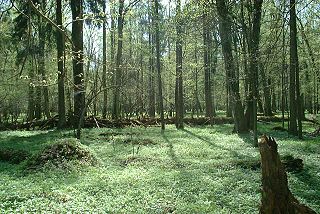Białowieża Forest
old forest in Poland and Belarus From Wikipedia, the free encyclopedia
old forest in Poland and Belarus From Wikipedia, the free encyclopedia
Białowieża Forest [1] is an ancient woodland. It is on the border between Poland and Belarus. It is 70 km (43 mi) north of Brest (Belarus) and 62 km (39 mi) southeast of Białystok (Poland). It is one of the last and largest remaining parts of the large primeval forest that once went across the European Plain.
This article may have too many red links. (September 2013) |
| Białowieża Forest | |
|---|---|
IUCN category II (national park) | |
 Wisent in natural habitat | |
| Location | Hrodna and Brest administrative districts of Belarus, Podlaskie Voivodeship in Poland |
| Coordinates | 52°45′N 23°59′E |
| Area | 152.2 km² |
| Established | 1932 |
| Governing body | Ministry of the Environment of Belarus and Poland |
This UNESCO World Heritage Site and Biosphere Reserve are in parts of the Brest Voblast and Hrodna Voblast in Belarus. On the Polish side they are near the town of Białowieża in the Podlaskie Voivodeship. Białowieża means the White Tower in Polish.
The border between the two countries runs through the forest. There is a border crossing for hikers and cyclists. The forest is home to 800 wisent, the continent's heaviest land animals.[2]
On the Belarusian side the Biosphere Reserve is 1,771 km2 (684 sq mi). The National Park and World Heritage Site are 876 km2 (338 sq mi). The Belavezhskaya Pushcha headquarters at Kamieniuki, Belarus has a laboratory and a zoo. The zoo has wisent, konik (a semi-wild horse), wild boar, moose, and other animals. There is also a small museum, restaurant, snack bar and hotel. Because of the lack of facilities and having few tourists in the country, few foreign tourists visit the Belarusian Pushcha each year.

On the Polish side, part of the Białowieża Forest is protected as the Białowieża National Park (Białowieski Park Narodowy). It has a general area of about 100 km2 (39 sq mi). There is also the Białowieża Glade (Polana Białowieska). This has several buildings first owned by the tsars of Russia. The tsars were the last private owners of the forest (from 1888 to 1917) when the whole forest was in the Russian Empire. A hotel, restaurant and parking areas are there. Guided tours into the strictly controlled areas of the park can be arranged on foot or by horse-drawn carriage. About 200,000 tourists visit the Polish part of the forest each year. Activities are: bird watching with local ornithologist,[3] watching bisons in their natural environment,[3] and sledge and carriage rides with a bonfire.[3] The popular village of Białowieża is in the forest.

The forest has a number of large, ancient pedunculate oaks (Quercus robur), some of which are individually named. Trunk circumferences are measured at breast height, 130 cm (51 in) above the ground.

Polish environmentalists say that logging is threatening the flora and fauna in the forest, including species of rare birds. Poland's state forestry board is saying that it is being done for protection and for ecological reasons.[5]
Seamless Wikipedia browsing. On steroids.
Every time you click a link to Wikipedia, Wiktionary or Wikiquote in your browser's search results, it will show the modern Wikiwand interface.
Wikiwand extension is a five stars, simple, with minimum permission required to keep your browsing private, safe and transparent.